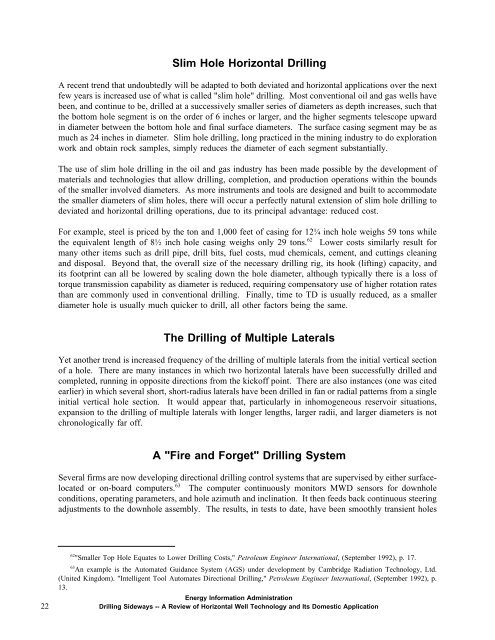Drilling Sideways -- A Review of Horizontal Well Technology ... - EIA
Drilling Sideways -- A Review of Horizontal Well Technology ... - EIA
Drilling Sideways -- A Review of Horizontal Well Technology ... - EIA
Create successful ePaper yourself
Turn your PDF publications into a flip-book with our unique Google optimized e-Paper software.
Slim Hole <strong>Horizontal</strong> <strong>Drilling</strong><br />
A recent trend that undoubtedly will be adapted to both deviated and horizontal applications over the next<br />
few years is increased use <strong>of</strong> what is called "slim hole" drilling. Most conventional oil and gas wells have<br />
been, and continue to be, drilled at a successively smaller series <strong>of</strong> diameters as depth increases, such that<br />
the bottom hole segment is on the order <strong>of</strong> 6 inches or larger, and the higher segments telescope upward<br />
in diameter between the bottom hole and final surface diameters. The surface casing segment may be as<br />
much as 24 inches in diameter. Slim hole drilling, long practiced in the mining industry to do exploration<br />
work and obtain rock samples, simply reduces the diameter <strong>of</strong> each segment substantially.<br />
The use <strong>of</strong> slim hole drilling in the oil and gas industry has been made possible by the development <strong>of</strong><br />
materials and technologies that allow drilling, completion, and production operations within the bounds<br />
<strong>of</strong> the smaller involved diameters. As more instruments and tools are designed and built to accommodate<br />
the smaller diameters <strong>of</strong> slim holes, there will occur a perfectly natural extension <strong>of</strong> slim hole drilling to<br />
deviated and horizontal drilling operations, due to its principal advantage: reduced cost.<br />
For example, steel is priced by the ton and 1,000 feet <strong>of</strong> casing for 12¼ inch hole weighs 59 tons while<br />
the equivalent length <strong>of</strong> 8½ inch hole casing weighs only 29 tons. 62 Lower costs similarly result for<br />
many other items such as drill pipe, drill bits, fuel costs, mud chemicals, cement, and cuttings cleaning<br />
and disposal. Beyond that, the overall size <strong>of</strong> the necessary drilling rig, its hook (lifting) capacity, and<br />
its footprint can all be lowered by scaling down the hole diameter, although typically there is a loss <strong>of</strong><br />
torque transmission capability as diameter is reduced, requiring compensatory use <strong>of</strong> higher rotation rates<br />
than are commonly used in conventional drilling. Finally, time to TD is usually reduced, as a smaller<br />
diameter hole is usually much quicker to drill, all other factors being the same.<br />
The <strong>Drilling</strong> <strong>of</strong> Multiple Laterals<br />
Yet another trend is increased frequency <strong>of</strong> the drilling <strong>of</strong> multiple laterals from the initial vertical section<br />
<strong>of</strong> a hole. There are many instances in which two horizontal laterals have been successfully drilled and<br />
completed, running in opposite directions from the kick<strong>of</strong>f point. There are also instances (one was cited<br />
earlier) in which several short, short-radius laterals have been drilled in fan or radial patterns from a single<br />
initial vertical hole section. It would appear that, particularly in inhomogeneous reservoir situations,<br />
expansion to the drilling <strong>of</strong> multiple laterals with longer lengths, larger radii, and larger diameters is not<br />
chronologically far <strong>of</strong>f.<br />
A "Fire and Forget" <strong>Drilling</strong> System<br />
Several firms are now developing directional drilling control systems that are supervised by either surfacelocated<br />
or on-board computers. 63 The computer continuously monitors MWD sensors for downhole<br />
conditions, operating parameters, and hole azimuth and inclination. It then feeds back continuous steering<br />
adjustments to the downhole assembly. The results, in tests to date, have been smoothly transient holes<br />
62 "Smaller Top Hole Equates to Lower <strong>Drilling</strong> Costs," Petroleum Engineer International, (September 1992), p. 17.<br />
63 An example is the Automated Guidance System (AGS) under development by Cambridge Radiation <strong>Technology</strong>, Ltd.<br />
(United Kingdom). "Intelligent Tool Automates Directional <strong>Drilling</strong>," Petroleum Engineer International, (September 1992), p.<br />
13.<br />
Energy Information Administration<br />
22 <strong>Drilling</strong> <strong>Sideways</strong> -- A <strong>Review</strong> <strong>of</strong> <strong>Horizontal</strong> <strong>Well</strong> <strong>Technology</strong> and Its Domestic Application

















